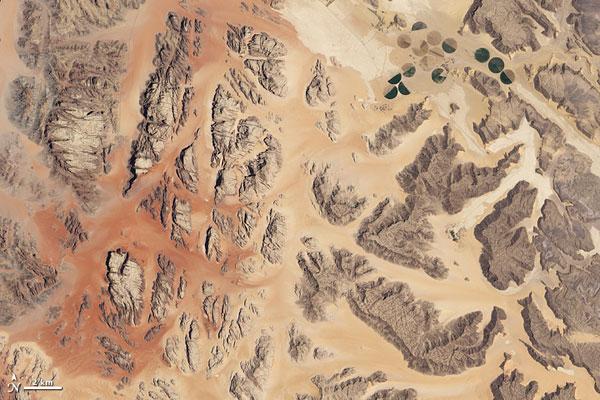
A 'Valley of the Moon' on Earth

In southwestern Jordan lies a landscape so alien it is nicknamed "Valley of the Moon."
Mountains of granite and sandstone rise next to valleys filled with red sand. Some of the mountains reach a height of about 5,600 feet (1,700 meters) above sea level, and many have near-vertical slopes.
The unearthly landscape, called the Wadi Rum, was declared a protected area in 1998.
The Advanced Land Imager (ALI) on NASA's Earth Observing-1 (EO-1) satellite captured this natural-color image on July 27, 2001. The scene includes part of Wadi Rum and an adjacent area to the east.
East of the protected area, fields with center-pivot irrigation make circles of green and brown.
As the earth tones throughout the image attest, the area is naturally arid, receiving little annual precipitation and supporting only sparse vegetation. Between rocky peaks, the sandy valleys range in color from beige to brick.
Ancient granite rocks dating from the Precambrian underlie younger rocks, and some of these basement rocks have eroded into rugged, steep-sloped mountains. The granite mountains have risen thanks partly to crisscrossing fault lines under the park. Overlying the granite are sandstones from the Cambrian and Ordovician Periods, as well as loose sands.
Get the world’s most fascinating discoveries delivered straight to your inbox.
Despite the region's seemingly inhospitable character , nomadic peoples have lived there for thousands of years.
Lawrence of Arabia, who fought in the Arab Revolt of 19171918, made frequent references to Wadi Rum in his book "The Seven Pillars of Wisdom," according to a NASA statement. Several popular sites in Wadi Rum bear Lawrence of Arabia's name, but whether he actually visited those sites is uncertain.
 Live Science Plus
Live Science Plus






